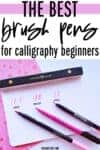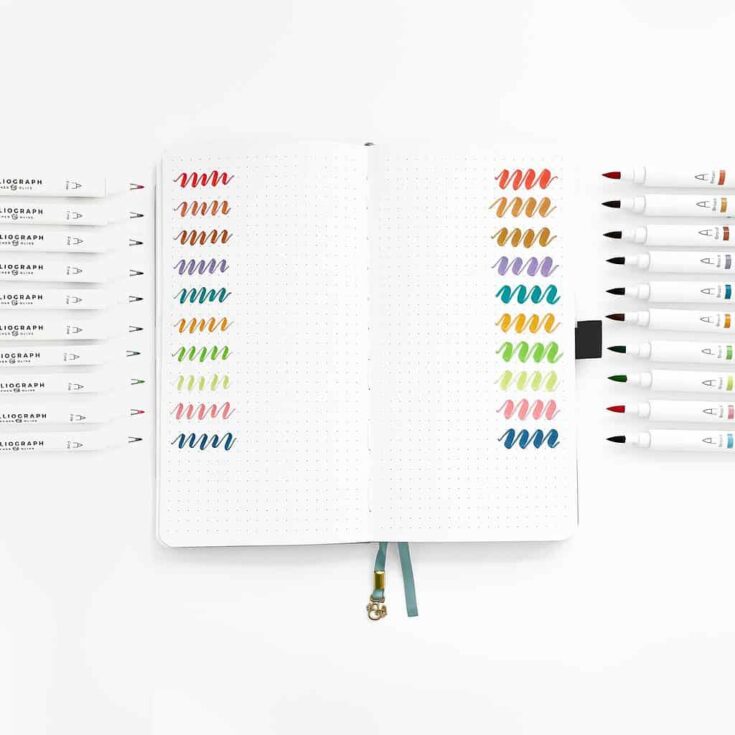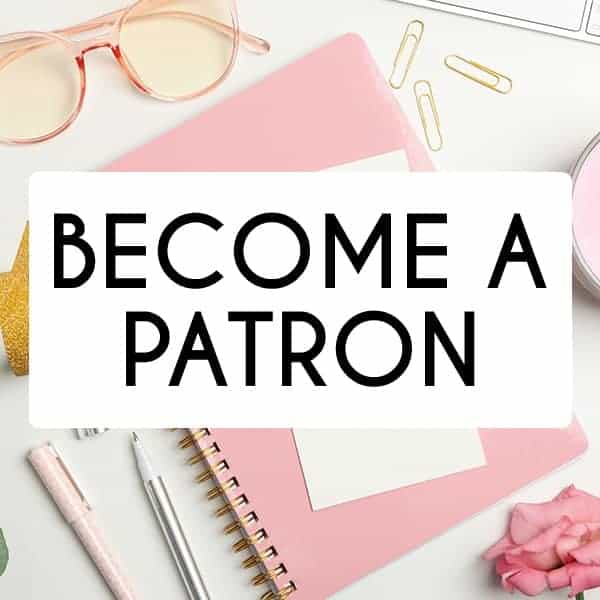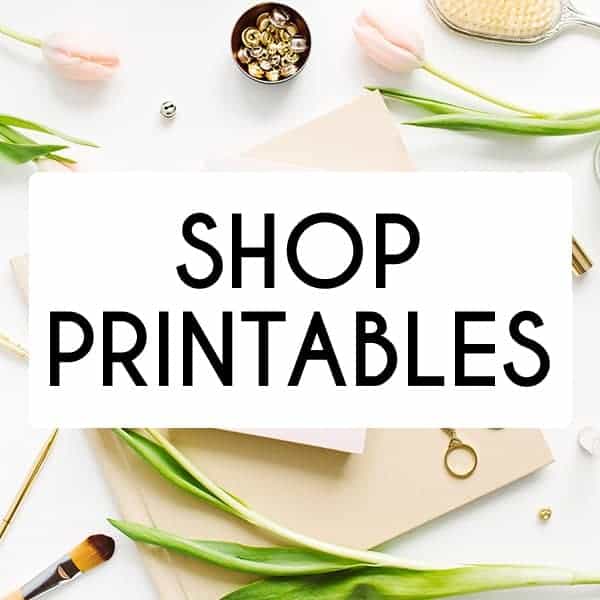The Best Brush Lettering Pens For Calligraphy Beginners
Today we’re talking about pretty exciting Bullet Journal supplies – brush pens.
Bullet Journal lettering and calligraphy are something I’ve always loved and constantly learning myself, and it’s a great way to make your journal pages pop.
And today, we’ll be taking the first step towards mastering brush lettering – I’ll help you find the best brush pens for you.

The stationery world can be pretty overwhelming. It was all just pens until I decided to learn Bullet Journaling and lettering.
Initially, it felt pretty overwhelming and scary, and there were so many options. How do I choose what’s best for me?
Well, I bought them all. Ok, maybe I’m exaggerating, but I decided to try as many as possible to see which ones would work best for me, and therefore now I’m ready to share my knowledge with you!

And don’t forget to scroll until the end, where I’ll give you my two best tips to ensure your pens don’t get damaged and serve you well for a long time.
But I want to start with the most important tip.
This post may contain affiliate links. They will be of no extra expense for you, but I receive a small credit. Please see my Disclosure for more details. Thank you for supporting Masha Plans!
You Don’t Need All The Pens
Here is a little secret – to start brush lettering, you can just use a soft pencil.
Yup, I said it.
When you’re starting to learn, the most crucial part is to learn the moves and make the mechanical, so your hand knows where to go. For that, a soft pencil would work just as well.
However, if you’re ready to get a pen, I got you covered with my best picks. And I get why you’d want to get one.
Starting something new is always challenging, and having a pretty pen will help to keep you motivated to practice. And modern calligraphy is all about practice.
What Is A Brush Pen
If you’re new in the lettering world, you might now know what a brush pen is, how it’s different from other pens, and why they are so popular for calligraphy.
Again, I got you covered!
Your usual writing pens are set to create a line with one thickness. No matter how you push on it or turn it – your writing pen will always produce a line with the same thickness.
Brush pens are the opposite, and they are created to draw both thick and thin lines, which is the core of many lettering styles, including modern calligraphy.
Brush pens usually have a flexible tip, like a paintbrush, which creates a wide variety of line thicknesses.
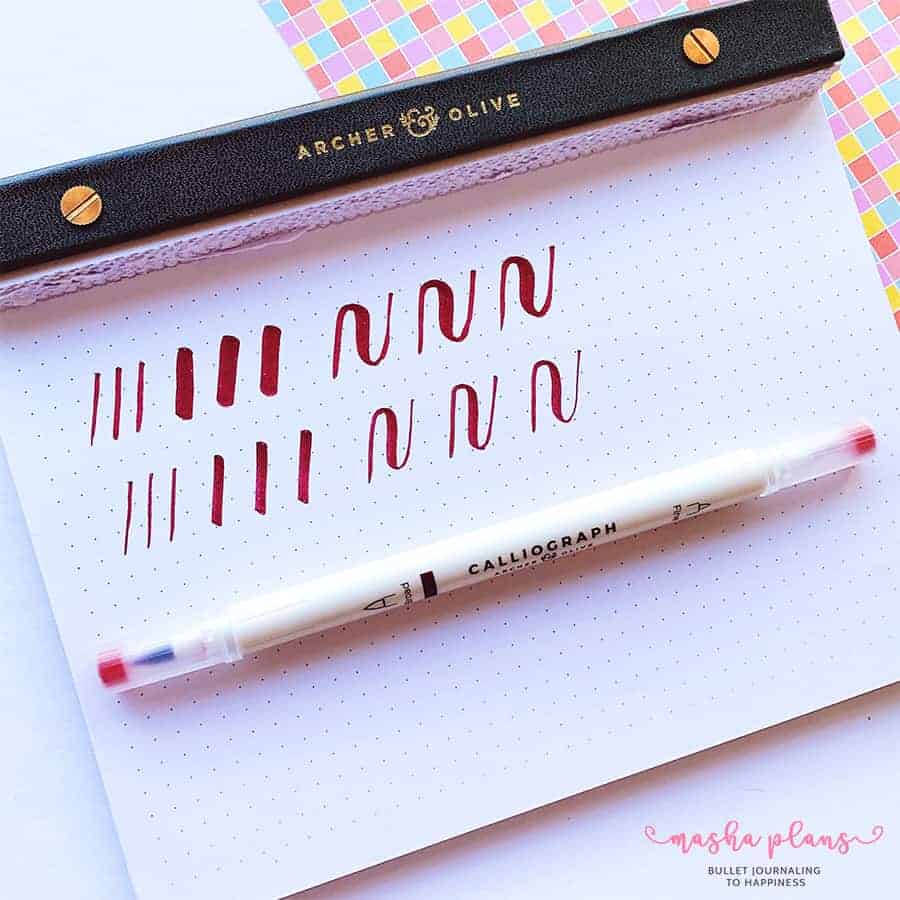
Brush Pen Characteristics
Here is a thing – all brush pens are different. All people are different, which means that everyone has their preference on what they want their brush pen to be.
That’s totally ok, so I’ll share here some main types of brush pens and some personal recommendations.
They are precisely that, through – recommendations. You might want to get something completely different from what I find best for beginners, so don’t take it as a set-in-stone rule.
That’s why I included in this list a wide variety of different types of pens, so you can check which characteristics you want to try and choose something you like.
Nib Size
The first and probably the most obvious one is the size of the nip. They come in large, medium, and small.
Something I want to mention here is that if you get a lettering worksheet is often just coming for small or large nibs. If you have a medium one – choose the worksheet for large ones.
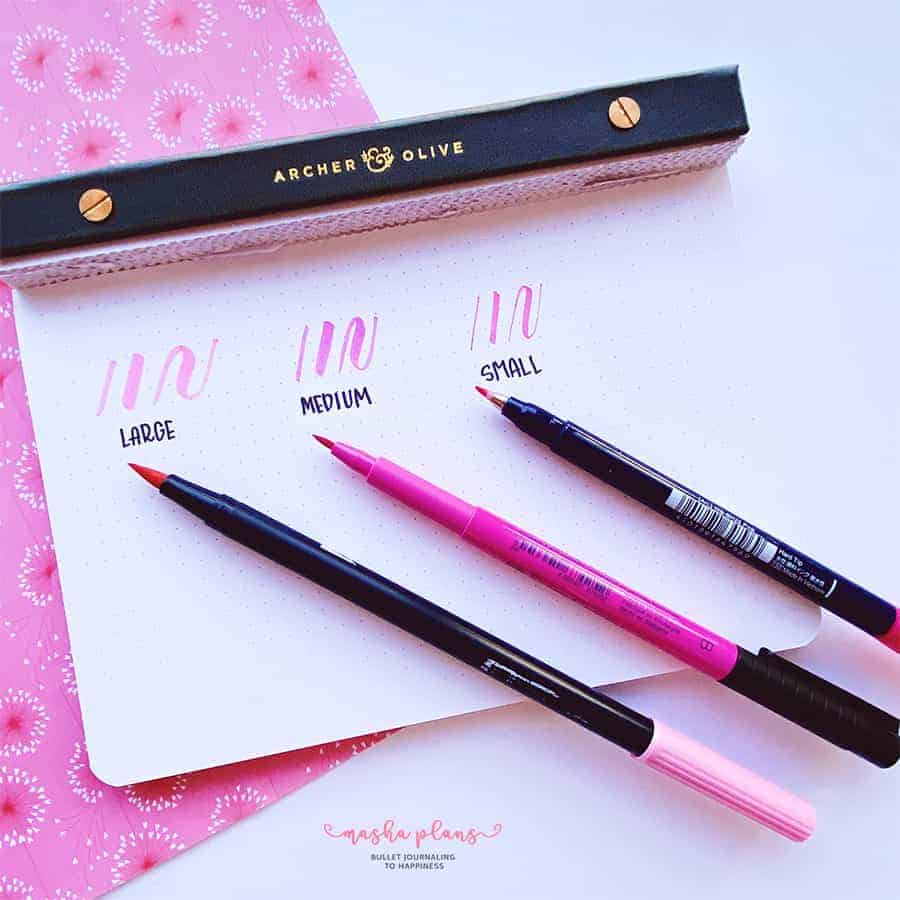
Nib Elasticity
This is how firm or soft a nib is. They can be soft, mid-firm, and firm.
I found that brush pens with the firm or mid-firm nib are easier to start with since they have a smaller range of line thickness and are easier to control.
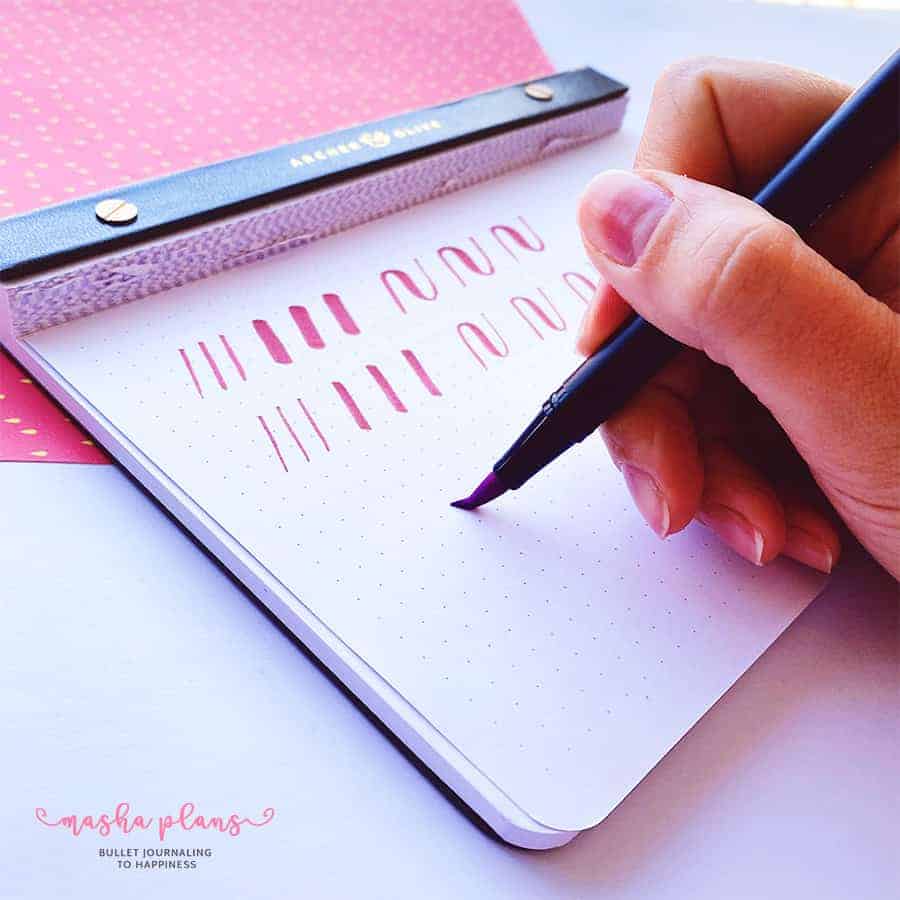
Ink Flow
Your brush pen can dispense ink differently, from pretty dry to very heavy.
I found that the drier the pen is, the easier it is to start with brush calligraphy. Also, if you have a Bullet Journal with thinner pages, you might want to avoid pens with heavy ink flow since they might lead to ghosting.
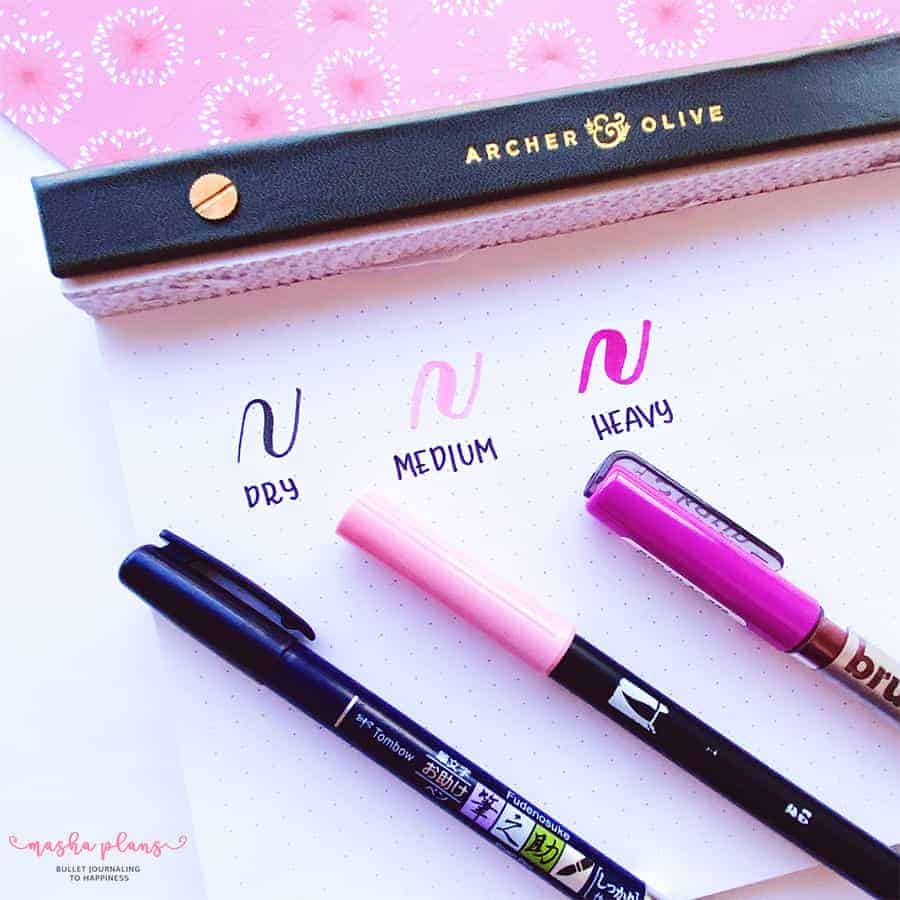
What should you start with – this is entirely up to you. My personal preference is the small brush pens with medium nib elasticity. But you might love something different.
So maybe you can start by getting one small tip brush pen and one large one. As you go, you can figure out what works best for you.
Best Brush Pens For Calligraphy Beginners
I don’t want to overwhelm you with an extensive list, so here I’ll just share with you 7 of my favorite pens.
Please don’t feel like you have to buy them all! Because you don’t.
I just wanted o share with you several different options so you can pick something for yourself depending on your needs and availability.
Ok, let’s dive into it!

These pens are probably the most popular on the market, and for a good reason. They are very high quality, come in tons of colors, and are very versatile.
You can blend them and use them as watercolors. Plus, they come with dual-tip – one is a brush nib, and one is a marker, making them useful for more than just brush lettering.
These pens have a large nib with medium elasticity and medium ink flow. If you want to try a large brush tip, these pens are probably the best to get started.

These were some of the first brush pens I’ve ever bought, and I’m still loving them.
The quality is excellent, and each pen has a color and a different shade of the same color, so that you can do a lot with these.
It’s a brush pen with large size nip (comparable to Tombow Dual Brush), mid-firm elasticity, and a wet ink flow.
They come in fewer colors, just 24 are available at the moment, but it’s a solid large tip brush for you to try.

These pens are a bit on the expensive side, but they are absolutely gorgeous.
Faber Castell Pitt Artist brush pens have a medium-sized soft nib with a wet ink flow.
The tip is so flexible that it might take a bit of extra time to master it, but these pens are worth it.
They come in many beautiful colors, and the medium nib is perfect for creating smaller lettering pieces, like headers for your weekly spreads.

These pens are not just high quality and available in many colors; they also are very durable. I’ve been using mine since I got them in 2018, and there is barely any damage to the nib.
These pens have a medium size nib with mid-firm elasticity and medium ink flow.
They are very comfortable to hold and are pretty easy to control stroke thickness.

These brush pens are probably the ones I use the most and the best ones, in my opinion, for beginners.
These brush pens have a small nib and come in both soft and hard nib versions. The ink flow in a medium and can be dry sometimes.
They are flexible and more durable than the large nib Tombow brush pens.
They used to be only available in black and grey, but recently Tombow released also ten different color versions of these brush pens.

Another set of pens with a small brush tip, these ones come in a bit more colors – there are a total of 24 available at the moment.
The nib is soft and has a medium wet ink flow.
They are pretty easy to control, making them also very beginner-friendly.

These are not precisely brush pens, but I had to include them in this list because they are incredibly affordable, and you can do brush calligraphy with them.
Crayolas don’t have a brush tip, so when you apply the pressure needed to mimic brush pens, they tend to degrade a little bit faster than the brush pen alternatives.
They also have a heavy ink flow, so there might be a ghosting issue in some of your journals.
Doing brush lettering with these pens might take a while to master, but you can take this Skillshare course (free with a 2-week trial using my link) to help you figure out the basics.
This is the new product from Archer and Olive, and I just had to include these pens because I’m absolutely in love with them.
Each pen has two tips – a large brush tip similar to Tombow Dual brush and a small brush tip similar to the hard Tombow Fudenosuke.
At the moment, they come in 20 colors, with 10 pens in each set.
They are very easy to use, and I love that in one pen, you get two different brush tips. That way, you can use them for brush lettering but also for smaller elements like daily headers for your Bullet Journal weekly spreads.
And, of course, please note that you can get it 10% off with my code MASHA10.
More Brush Pen Recommendations
If you want to get some opinions in a video format, I found this great video about the best pens for beginners.
Some of them are not on my list, but that’s simply because I had to keep it short. I haven’t tried all the pens she’s talking about, but I agree with her opinions on the ones I tried myself, so I’m sure her other recommendations are also worthy.
So here are a few recommendations from the video if you want to try them out:
- Zebra Brush Pens
- Zebra Funwari Brush Pen
- Zig Cocoiro
- Fibralo Brush Pen
- Stabilo Brush Pens
- Sharpie Stained Markers
- Zig Fudebiyori
- Winsor And Newton Watercolor Brush Marker
- Crayola Broad Line Markers
Calligraphy Brush Pen Tips
After I got my first brush pen and started using it, it frayed pretty fast. That’s because there are a few more things you should consider when using a brush pen.
But don’t worry; I’m here to share my mistakes and make sure you avoid them.
Use Good Paper
This is not something I thought about when I started printing out my lettering worksheets, but you must use high-quality, smooth paper.
And this is not only about practicing your lettering; when you decide to create a lettering artwork, you also have to make sure the paper you use is high quality.
If you opt-out for cheap rough paper, you’ll end up fraying your pen nib, plus there is a high chance that it will bleed through.
The best paper for using brush pens is:
- Marker paper
- HP Premium 32
- Rhodia notepad
- Tracing paper
- Archer and Olive notepad (which has been my favorite lately, and I can give you 10% off your purchase with code MASHA10)
Store Your Brush Pens Correctly
The second most important thing for preserving the health of your brush pens is to store them correctly.
If you store them vertically, there is a chance the nib might dry out or get oversaturated, depending on which side is down.
It’s essential that you store your pens horizontally; that way, the ink will be distributed evenly, and your pens will serve you more.
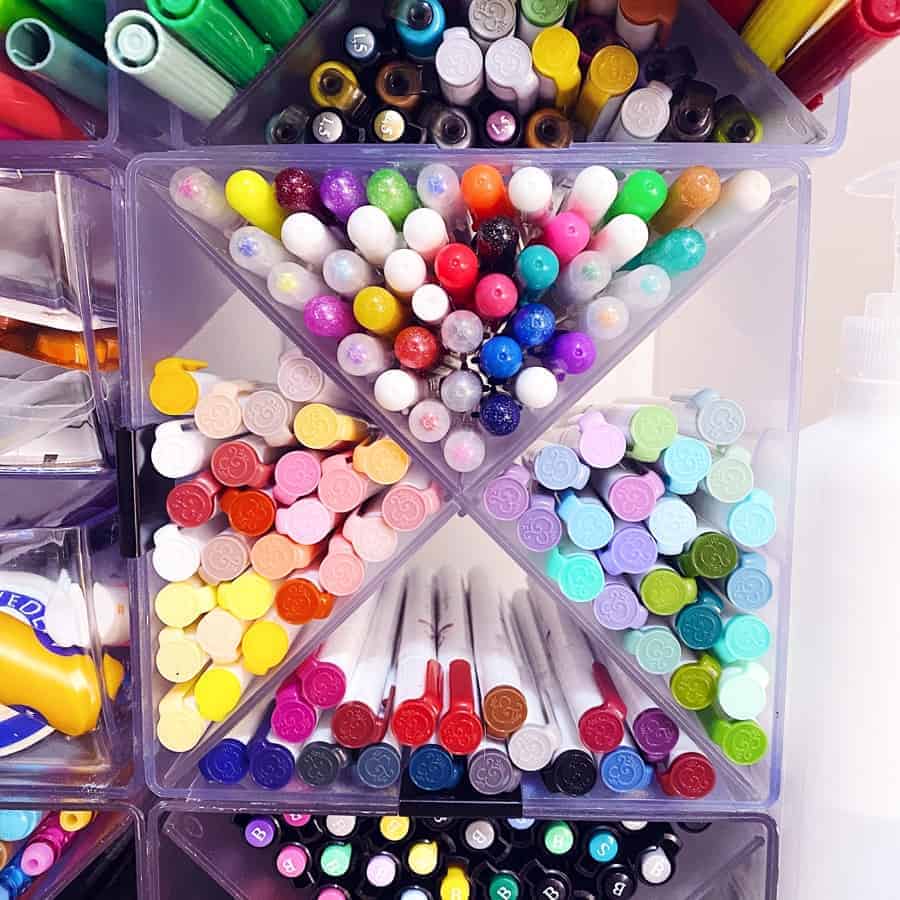
Of course, there are exceptions, like Karin Brushmarker Pro Brush Pens, but these specifically state that you should store them vertically.
So here is the golden rule – unless it’s explicitly stated – store your pens horizontally.
If you’re looking for good storage, I recommend this one. I use it to store all my pens and absolutely love it.
Free Brush Lettering Resources
Brush lettering is a very fun hobby, and you can do so much with just a few pens. Mastering brush lettering is also all about practice, so I created a few resources to help you with that.
Simply sign up in the form below, and you’ll get exclusive practice worksheets and more information on mastering lettering delivered straight to your inbox.
Learn Brush Lettering: Resources
If you’re here looking for a brush pen to start your calligraphy journey, chances are you’re a beginner.
So here are some posts to help you with that:
- Beginner’s Guide To Brush Lettering
- Free Online Calligraphy Courses
- Free Printable Brush Lettering Worksheets
Which one of these pens do you want to try? Let us know in the comments!
And remember – there is no one best pen; we all have different things we like.
So just try what you want and find a pen that fits you the best.
Hope this post was useful, if you find it so, please share! If you enjoy my content and want to show your appreciation, please consider supporting me with a cup of coffee.
And remember: Keep Bullet Journaling, and Don’t Be A Blob.


